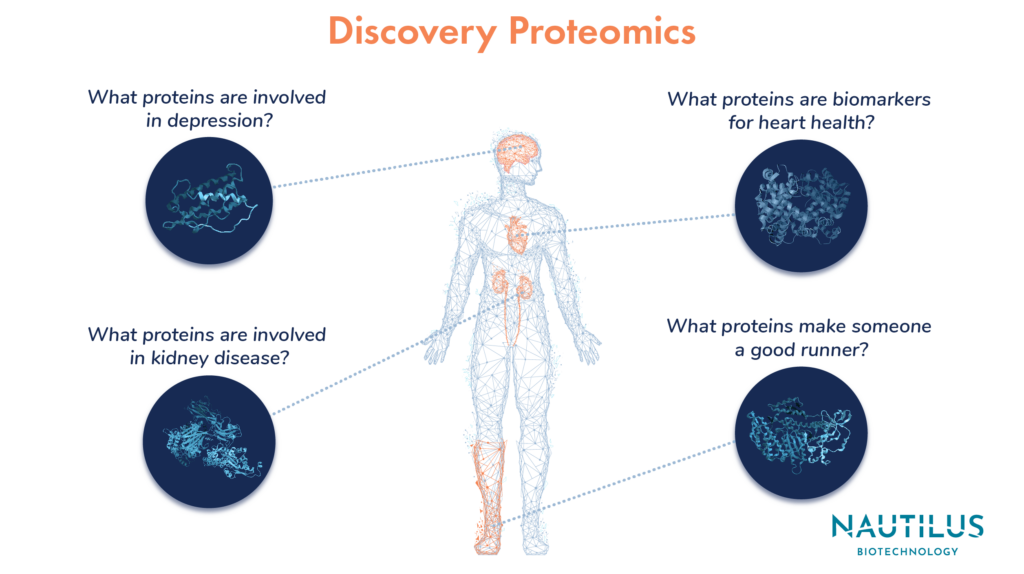
Discovery proteomics is an approach that enables scientists to identify the proteins in a sample without much prior knowledge of that sample. It stands in contrast to targeted proteomics approaches that specifically study a protein or group of proteins of interest.
The proteome, the collection of all proteins in a cell, tissue, or sample, contains a vast amount of information about biological functions. Depending on what is already known about a particular proteome, proteomics researchers may need to do some groundwork before they can dive into nitty gritty research questions.
A great way to establish a baseline understanding of a proteome is to sample it in a non-targeted way, using a technique broadly called discovery proteomics. Sometimes also called untargeted proteomics, this type of proteomic profiling consists of surveying a sample of interest to see what proteins, and variants known as proteoforms, it contains, without necessarily having a hypothesis beforehand. Scientists use discovery proteomics to illuminate the dark regions of the proteome and unveil the inner workings of biology.
Using discovery proteomics to understand biology
Discovery proteomics is a first, crucial step in understanding the proteome of anything from a single cell to an entire organism. Proteins are ubiquitous in biology, controlling fundamental processes ranging from DNA transcription to metabolic transformations. Much of the proteome is still unstudied, meaning that we have much left to learn about what many proteins do, how they interact with other proteins, and how protein function impacts an organism.
Discovery proteomics can give scientists a first look at the complex and fundamental processes underlying diverse cells and organisms. From sampling the proteome of a tumor biopsy, to identifying proteins involved in kidney disease, to finding proteins associated with mental health, to studying the proteome of a new species of bacteria, discovery proteomics can provide a broad view of the pathways functioning in biological systems. Untargeted proteomics studies like this can point to new avenues of research, or give important hints about which biological pathways are most important for a specific function.
With current technologies it is difficult to conduct discovery proteomics research that matches the scale of the proteome. We are designing the NautilusTM Proteome Analysis Platform to make truly broadscale proteomics efforts accessible to all biology researchers.
Techniques for discovery proteomics
Scientists typically use a technique called mass spectrometry to do discovery proteomics. The technique involves breaking proteins into small fragments and separating them by mass to identify individual molecules. While mass spectrometry has played a role in crucial advances in our understanding of proteomics thus far, new technologies will extend the capabilities of proteomics platforms even further with more user-friendliness, better dynamic range, and the ability to see nearly the entire proteome of a sample.
Next-generation proteomics technologies, including the NautilusTM Proteome Analysis Platform, may soon take the field of discovery proteomics to new heights, expanding the insights that researchers can glean through a first glance at the proteome. We often refer to this type of work with the NautilusTM Platform as “broadscale proteomics,” to highlight the broad dynamic range of protein abundance our platform is designed to cover.
Discovery proteomics applications
Over the past few years, discovery proteomics has increasingly popped up in the scientific literature. For example, in a 2019 study in eLife, a team of researchers from the National Institute of Health’s National Institute on Aging used discovery proteomics to study the biological underpinnings of sarcopenia or the loss of strength that occurs with age.
The researchers took skeletal muscle samples from 58 people who ranged in age from 20 to 87 years old, and performed a quantitative proteomic analysis to see what proteins were present and in what quantities. By tallying up over 4,300 proteins, they found that the muscles of older participants had fewer ribosomal proteins (that is, proteins involved in making new proteins) and fewer proteins involved with energy production, as well as higher levels of immune proteins and proteins related to the regulation of transcription and maintenance of the genome.
While the researchers’ discovery proteomics work doesn’t highlight any definitive ways to keep us from losing strength as we get older, it does begin to lay the groundwork for future studies of specific aspects of muscle loss and aging. Confirming that ribosomal proteins decrease with age could help focus future aging research on ribosomes, for example. With more research, new ways to prevent sarcopenia could emerge, something that’s currently not possible.
This is just one example of the applications of discovery proteomics. Scientists can use untargeted proteomics approaches to gain insights into a wide variety of research questions and kickstart multiple research or clinical development projects.
New tools will make discovery proteomics more powerful
For discovery proteomics to truly yield powerful insights, we need tools that have the sensitivity and dynamic range to see the whole proteome of any sample. That’s especially true for complex processes like sarcopenia, which involve many proteins working together.
The Nautilus Proteome Analysis Platform aims to enable comprehensive broadscale proteomics and accelerate discovery proteomics. There’s a vast world of proteomics to explore, meaning we’ll need many scientists around the world to do it. With accessible next-generation proteomics technologies, researchers may finally be able to reveal the secrets of the proteome.
MORE ARTICLES


